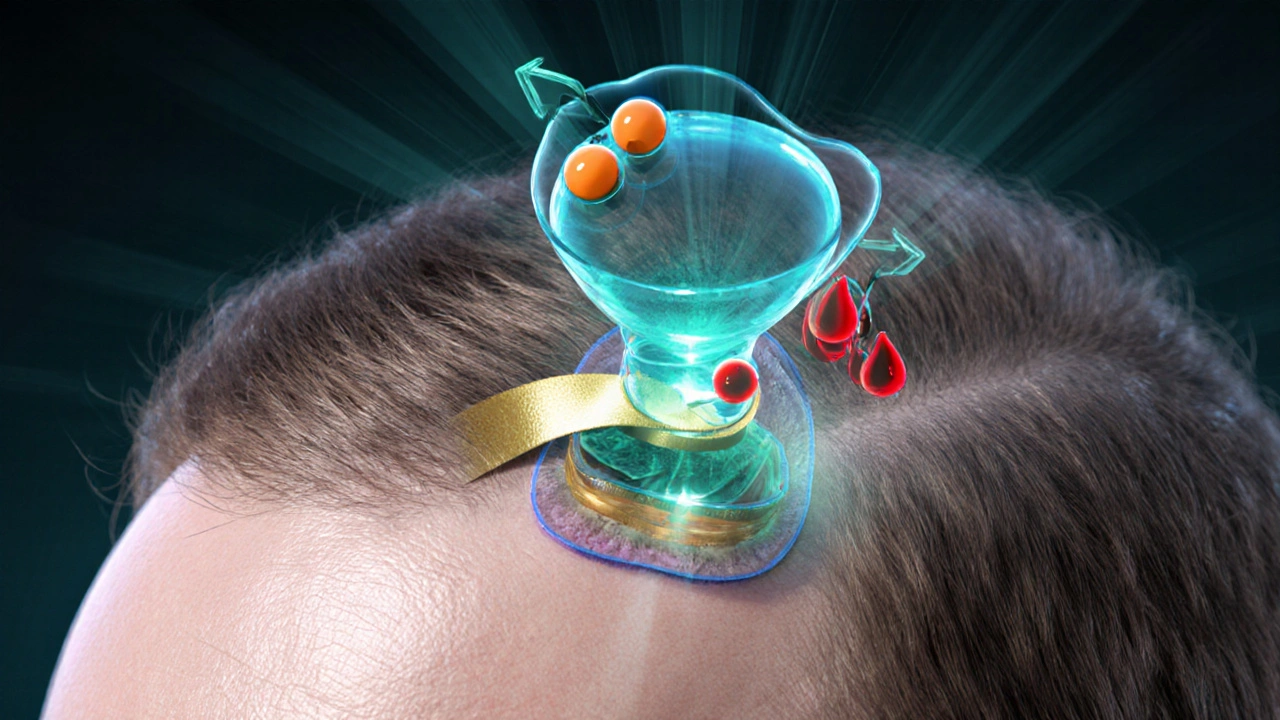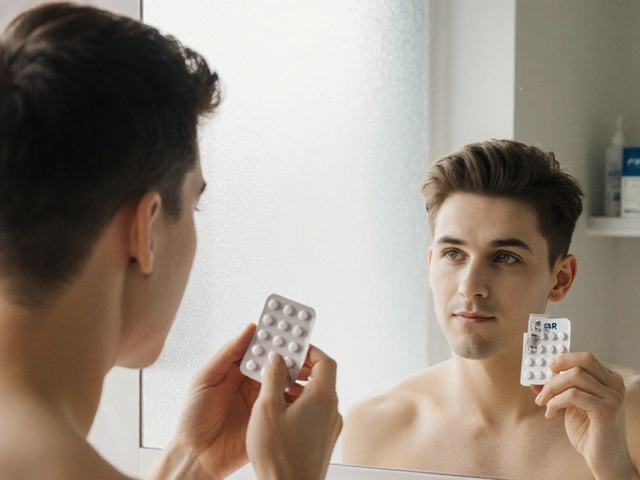Hair Loss Treatment Comparison Tool
Select Your Profile
Answer these questions to get personalized recommendations for hair loss treatments.
Recommended Treatment Based on Your Profile
Detailed Comparison
| Treatment | Delivery Method | Primary Action | Effectiveness | Side Effects |
|---|
Millions of men and women battle thinning hair, and the market is flooded with pills, foams, lasers, and even surgical options. With so many choices, figuring out whether Finasteride - sold in many countries as Fincar - is the right move can feel overwhelming. This guide breaks down how Fincar works, what you might expect, and how it stacks up against the most popular alternatives.
What is Fincar (Finasteride)?
Finasteride is a synthetic 5‑alpha‑reductase inhibitor originally approved by the FDA in 1997 for benign prostatic hyperplasia and later for male pattern hair loss (androgenetic alopecia). The brand name Fincar is the same drug marketed in several Asian and European markets.
Key attributes:
- Form: oral tablet, usually 1mg for hair loss.
- Mechanism: blocks the TypeII isoenzyme that converts testosterone into dihydrotestosterone (DHT), the hormone that shrinks hair follicles.
- Effectiveness: clinical trials show ~80% of users experience a halt in hair loss after 12months, with 30‑40% reporting noticeable regrowth.
- Common dose: one tablet daily, taken with or without food.
- Regulatory status: prescription‑only in most countries; over‑the‑counter versions exist in a few regions under different brand names.
How Finasteride Works at a Molecular Level
Finasteride binds to the active site of the TypeII 5‑alpha‑reductase enzyme, preventing the conversion of testosterone (T) to DHT. Because DHT is the primary driver of follicular mini‑miniaturisation in androgen‑sensitive scalp areas, lowering its concentration reduces follicle shrinkage and can reverse early‑stage thinning.
Blood tests in users show a 65‑70% drop in scalp DHT levels within two weeks of starting therapy. The drug does not significantly affect estrogen or cortisol pathways, which explains its relatively focused side‑effect profile.
Typical Side Effects and Precautions
While many tolerate Finasteride well, the drug isn’t free of drawbacks:
- Sexual dysfunction (decreased libido, erectile difficulty) - reported in 2‑4% of users, often reversible after discontinuation.
- Hormonal changes (slight rise in serum testosterone, mild breast tenderness) - usually asymptomatic.
- Potential mood alterations - rare case reports of depression and anxiety.
- Pregnancy warning - tablets must be kept away from pregnant women because of possible birth‑defect risk.
Because the benefits appear after several months, doctors typically recommend a trial of at least six months before deciding whether to continue.

Popular Alternatives to Finasteride
When Finasteride isn’t suitable - due to side effects, prescription barriers, or personal preference - several alternatives fill the gap. Below is a snapshot of each option.
- Dutasteride: a dual 5‑alpha‑reductase inhibitor (targets both TypeI and II enzymes). Often prescribed off‑label for hair loss at 0.5mg daily.
- Minoxidil: a topical vasodilator available over the counter in 2% (women) and 5% (men) foam or solution.
- Spironolactone: an oral potassium‑sparing diuretic with anti‑androgen properties, mainly used in women.
- Low‑Level Laser Therapy (LLLT): handheld or cap‑style devices emitting red‑light photons to stimulate follicular metabolism.
- Saw palmetto extract: a botanical supplement that mildly inhibits 5‑alpha‑reductase, sold as capsules or gummies.
- Platelet‑Rich Plasma (PRP) injections: an in‑office procedure where autologous plasma is centrifuged and re‑injected into the scalp.
Side‑by‑Side Comparison
| Attribute | Finasteride (Fincar) | Dutasteride | Minoxidil (Topical) | Spironolactone | LLLT |
|---|---|---|---|---|---|
| Delivery method | Oral tablet | Oral tablet | Topical solution/foam | Oral tablet | Device (cap or hand‑held) |
| Primary action | Inhibits TypeII 5‑α‑reductase (≈70% DHT drop) | Inhibits TypesI &II (≈90% DHT drop) | Vasodilation → increased blood flow | Blocks androgen receptors | Photobiomodulation → ↑ ATP in follicle cells |
| Typical dosage | 1mg daily | 0.5mg daily (off‑label) | 2% (women) or 5% (men) twice daily | 50‑100mg daily | 10‑30min, 3‑5times/week |
| Prescription needed? | Yes (most regions) | Yes (off‑label) | No | Yes | No (device purchase) |
| Onset of visible results | 3‑6months | 3‑6months | 4‑6months | 4‑6months | 6‑12months |
| Common side effects | Sexual dysfunction, mood changes | Similar to finasteride, possibly higher | Scalp irritation, unwanted hair growth | Breast tenderness, electrolyte shift | Transient scalp warmth, eye strain |
| Cost (US average) | $30‑$60/month (generic) | $70‑$120/month | $20‑$45/month | $25‑$45/month | $200‑$800 (device purchase) |
Choosing the Right Option for Your Situation
Not every treatment fits every person. Below is a quick decision matrix to help you match your profile with the most suitable choice.
- Male, early‑stage thinning, no major health issues: Finasteride or Dutasteride are first‑line because they target the underlying DHT cause.
- Male, intolerant to oral meds or prefers non‑prescription: Minoxidil 5% foam works well, especially when combined with a DHT‑blocking supplement.
- Female, hormonal acne or PCOS‑related hair loss: Spironolactone or low‑dose oral contraceptives are often more effective than DHT blockers.
- Anyone worried about systemic side effects: LLLT offers a drug‑free route, though it requires consistent use and higher upfront cost.
- Those seeking rapid cosmetic improvement for a special event: PRP sessions can deliver noticeable thickening within 3‑4months, but they’re pricey.
Keep in mind that many clinicians recommend a combination approach - for example, Finasteride plus Minoxidil - to attack hair loss from both hormonal and vascular angles.

Practical Considerations Before Starting
Before you write a prescription or click “add to cart,” ask yourself these questions:
- Do I have a confirmed diagnosis of androgenetic alopecia? A dermatologist can rule out other causes such as thyroid disorders or alopecia areata.
- Am I comfortable with a daily oral pill and possible lab monitoring? Baseline liver function and prostate‑specific antigen (PSA) tests are common for men over 35.
- What’s my budget for long‑term therapy? Some drugs are cheap generics, while devices and procedures can run into thousands.
- Do I have any contraindications (e.g., pregnancy, severe liver disease, potassium‑sparing diuretic sensitivity)?
- Am I prepared for a 4‑6‑month waiting period before seeing results? Patience is key.
If you answer “yes” to most of these, Finasteride or its alternatives are worth a trial.
Monitoring Progress and When to Stop
Track your hair density with monthly photos taken from the same angle and lighting. Many apps now calculate hair‑coverage percentages, making it easier to spot subtle changes.
Typical milestones:
- Month3: Expect stabilization - no further shedding.
- Month6: First signs of regrowth (new fine hairs) may appear.
- Month12: Full effect plateau; decide whether to continue.
If after six months you see no halt in shedding or if side effects become intolerable, discuss discontinuation with your doctor. Most adverse effects recede within weeks after stopping, but a short taper (e.g., every other day for two weeks) can sometimes ease the transition.
Frequently Asked Questions
Can women use Finasteride?
Finasteride is not approved for use in pre‑menopausal women because it can cause birth defects. Post‑menopausal women sometimes use it off‑label under strict supervision, but most physicians prefer spironolactone or topical minoxidil for female patients.
How does Dutasteride differ from Finasteride?
Dutasteride blocks both TypeI and TypeII 5‑alpha‑reductase enzymes, reducing scalp DHT by up to 90% versus 70% with Finasteride. This can mean slightly better hair‑growth results, but the broader inhibition also raises the risk of sexual side effects.
Is it safe to combine Finasteride with Minoxidil?
Yes, many dermatologists prescribe the combo because the drugs work through separate pathways - Finasteride cuts DHT, while Minoxidil boosts blood flow. The combination often yields faster and fuller results than either alone.
What are the main risks of long‑term Finasteride use?
Long‑term users mainly report persistent sexual dysfunction (rarely lasting after discontinuation) and, in a small subset, mood changes. Regular check‑ups help catch any unexpected lab changes early.
How much does a typical Finasteride treatment cost?
A generic 1mg tablet costs between $30 and $60 per month in the United States, depending on pharmacy and insurance coverage. Brand‑name versions can be double that price.
Next Steps
If you’ve narrowed down a preferred option, schedule a brief tele‑consultation with a board‑certified dermatologist. Bring any recent lab results, a list of current medications, and a few photos of your scalp. The clinician can then tailor dosage, discuss monitoring, and set realistic expectations.
Remember, hair loss is a marathon, not a sprint. Whether you pick Finasteride, Dutasteride, Minoxidil, or a laser cap, consistency and realistic goals are the keys to success.


Justin Channell
Stay consistent and you’ll see results 😊
Basu Dev
Finasteride works by inhibiting the type II 5‑alpha‑reductase enzyme, which reduces the conversion of testosterone into dihydrotestosterone (DHT). By lowering scalp DHT levels, the drug directly addresses the hormonal driver of androgenetic alopecia. Clinical trials have shown that about 80 % of male users experience a halt in shedding within three to six months. Furthermore, approximately 30‑40 % report visible regrowth of fine hairs after a year of continuous use. The medication is administered orally as a 1 mg tablet taken once daily, which makes adherence relatively simple compared to topical regimens. Side‑effects are generally mild, with sexual dysfunction reported in roughly 2‑4 % of patients, and these effects often resolve after discontinuation. Mood alterations have been noted in isolated cases, highlighting the importance of monitoring mental health during therapy. Baseline laboratory testing, including liver function and prostate‑specific antigen (PSA) levels, is advisable for men over 35 before initiating treatment. Regular follow‑up appointments enable the clinician to assess efficacy and adjust dosage if necessary. It is also critical to inform patients that the benefits of finasteride are maintained only while the medication is continued; discontinuation typically leads to a reversal of gains within several months. Patients should be patient, as the visible improvement timeline ranges from three to twelve months depending on individual response. Combining finasteride with a topical agent such as minoxidil can provide synergistic results, targeting both hormonal and vascular pathways. In women of child‑bearing age, finasteride is contraindicated because of the risk of birth‑defects, making alternative therapies like spironolactone or topical minoxidil more appropriate. Finally, the cost of generic finasteride in the United States averages between $30 and $60 per month, offering an affordable option compared to many newer hair‑loss technologies. For anyone considering this therapy, a thorough discussion with a board‑certified dermatologist is essential to weigh the benefits against potential risks.
Krysta Howard
The article glosses over the serious risk of persistent sexual side‑effects, which many users report even after stopping the drug 😠. While the efficacy numbers look impressive, the real‑world experience can be quite different, especially for those with pre‑existing mood disorders. Ignoring the long‑term hormonal impact does a disservice to readers looking for a balanced view. A more nuanced discussion of post‑finasteride syndrome would have made this guide far more responsible.
Elizabeth Post
You’re on the right track, keep tracking progress and stay patient.
Brandon Phipps
I’ve been following the combination approach for a year now, and the results speak for themselves. The key is consistency – taking finasteride every morning without missing a dose, and applying minoxidil twice daily after showering. I also make sure to keep my scalp clean and avoid harsh shampoos that can strip the follicles. In my case, the hair density on the crown increased by about 20 % after six months, which is a noticeable improvement. I monitor my PSA levels annually, and so far everything looks normal. If you’re worried about side‑effects, start with a lower dose of finasteride and see how you tolerate it – many patients do well on 0.5 mg. Also, remember that lifestyle factors like diet, stress management, and sleep quality play a supporting role in hair health. A diet rich in omega‑3 fatty acids, zinc, and biotin can boost the overall environment for hair growth. Lastly, give the treatment at least a year before deciding whether to continue – hair cycles are slow, and premature judgment often leads to unnecessary discontinuation.
yogesh Bhati
If hair is a forest, finasteride is the rain that makes tree groww.
Akinde Tope Henry
DHT blockers work, no doubt.
Brian Latham
Seems like another sales pitch.
Barbara Todd
The long‑term hormonal balance effects are something to consider.
nica torres
Let’s keep the momentum going, you’ve got this!
Dean Marrinan
Oh great, another miracle pill – because we all love magic in a bottle 😂.
Oluseyi Anani
In the grand scheme of health, opting for evidence‑based treatment is simply the responsible choice.